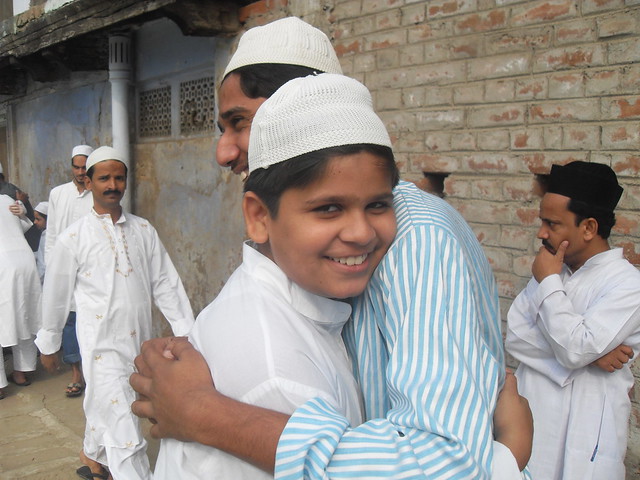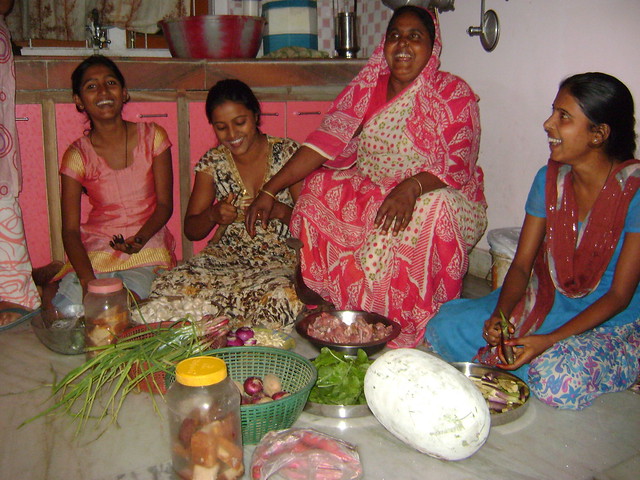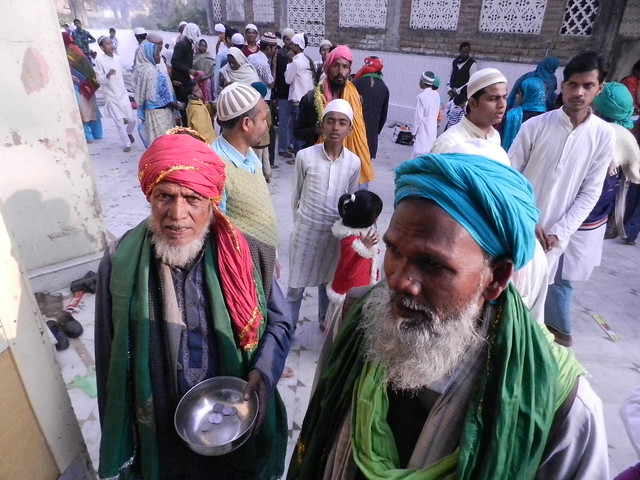By Rakhshanda Jalil
I cannot imagine Eid without the nervous anticipation of the previous night. Nor the beginning of Ramzan without the nail-biting tension of not knowing. Does one fast the next day, or does one not? Does one stay up all night cooking for the feast that must follow the next day, or does one keep all preparations on hold for another day? Does one set the alarm for the pre-dawn meal, or does one enjoy the luxury of sleeping a few more hours? For, everything depends on the sighting of the new moon, the hilal, the proverbial Eid ka chand which, quite literally, kal ho na ho!

The evening before Eid people crowd on rooftops, vying to catch the first sight of the new moon, which is usually a silvery crescent skimming the tops of the tallest trees for a few short moments and gone in the twinkling of an eye. Soon after the iftaar and hurried maghrib prayer (especially hurried because the new moon can be sighted only for a few precious moments in the western sky), the young and the old rush outdoors to ‘sight’ the moon. The older, more experienced members of the family tell the younger ones where, exactly, to train the eyes, for the new moon is not high in the sky, nor is it very clearly visible. One must know exactly where to look. So, between excited cries of ‘There!’ There!’, ‘Between those two trees’ or ‘There, next to that bit of cloud!’ or ’Just above that building over there’, everyone is craning their necks, standing on tiptoe, busy pointing and peering. The scene is unchanging, year after year, in families rich and poor, rural or urban, nuclear or joint.
A great deal of Urdu poetry centers on the Eid ka chand – ranging from flowery verses found in greeting cards to some delightfully evocative lyrics. Poets have waxed eloquent on the excitement surrounding the sighting of the new moon, its tremulous beauty, its delicate shape like an arched eyebrow perched on the forehead of the twilight sky and the feverish anticipation it generates among its viewers. On its beauty, Shahryar has written:
Eid ke chand tujh nikalne se
Aasman husn mein izafa hua
(Eid Moon, with your appearance
The beauty of the sky is enhanced)
On the delights that follow its sighting Tilok Chand says,
Door se yeh tera ishara hai
Auj par aish ka sitara hai
(From a distance you have indicated
The delights that shall soon reach their zenith)
Then there are the cornier sentiments associated with the opportunities of closeness afforded by the festivities:
Eid ka din hai gale aaj to mil le zalim
Rasm-e-duniya bhi hai mauqa bhi hai, dastur bhi hai
(It is Eid today, come embrace me, O cruel one
Tradition allows it, so does the time and occasion)
The moon once sighted, or in its absence the news confirmed by TV and radio channels and increasingly via SMS, the telephone lines begin to jangle. ‘Mubarak ho, chand dikh gaya, kal eid hai!’ (Congratulations, the moon has been sighted; it is Eid tomorrow!) And among women, more often than not, the greeting is followed by solicitous enquiries about one’s state of preparedness: Has the tailor given the clothes? Have you stocked up on enough qeema for the kababs? Have you bought seviyan? Is there enough milk? Have you set the curd and soaked urad dal for dahi barhe? Are you done with your dusting, cleaning, polishing?

The work that goes into preparing Eid feast.
For me, chand raat, the night before Eid, conjures up images of frenetic activity and a great deal of excitement and clamour: young girls putting mehndi and trying on new dresses, the clatter of crockery being washed and stacked for the next day, masalas being fried, and copious amounts of foods being cooked. While the men may lounge about smoking, chatting, drinking tea or eating – relaxing, as it were, after the month-long fasting — the women are usually busy preparing for the endless feasting the next day.
In almost all Muslim homes people drop in unannounced to exchange greetings and eat! Eid is open day – no invitations are issued and none are expected. Streams of visitors pour in to greet, embrace and partake of the goodies piled upon groaning tables. The day follows a similar pattern in most Muslim households. The women get up early to supervise the food, clean the house, especially the dining areas, lay out every bit of crockery and cutlery (despite this, the day entails endless dishwashing and no matter how many spoons and glasses you lay out, you always seem to run short). The men bathe, put on new clothes, dab ittar (perfume) and go for the congregational Eid namaz jingling a lot of loose change which is meant to be distributed to the beggars who line up at the mosques.
In my childhood, I remember Eid mornings as a time of great hustle and bustle. My mother rushing from the kitchen to the buffet table, my father hurrying my brother who was always late for the namaz and because of whom both my father and brother ended up being the last people to catch the namaz, often offering it on the road since the masjid would be chockablock by the time they made it. My brother, who only ever went to the masjid on the occasion of the two Eids, would not find his cap or more often than not, oversleep. My mother would rush from the kitchen to his room, chivvying him into hurrying up and ensuring he wore his new kurta pajamas. My father would pace the living room, waiting for him while my sisters and I regaled each other with incidents of past Eids: who came wearing what, who gave how much Eidi money or how the biryani at Mrs X’s home was vastly superior to Mrs Y’s.
By 9.30 the men are usually back from the masjid and the doorbell has already begun to ring endlessly, heralding the arrival of visitors which will show no signs of relenting till a little after lunch and then, after a short lull between 3.00-4.00 pm when the household draws a breath, the kitchen staff finishes washing mounds of used cutlery, men take a nap and women freshen up for the evening assault, the visitors start again. In between all this, one steals out for a few hurried calls – to elderly relatives, neighbours and most importantly the graveyard. Men make time to visit the graveyard on their way back from the mosque; women at any point in the day.

Don’t forget the fitra part of Eid-ul-Fitr.
Amidst the general bonhomie and good cheer, the excitement of new clothes and gifts, it is easy to forget that Eid is not merely an occasion to binge, grab Eidi money, visit melas and milans and display the conspicuous consumption of wealth; it carries an important message which is integral to the spirit of Islam. Its very name, Eid-ul-Fitr, is resonant with the message of thanksgiving and sharing. Every Muslim is duty bound to pay the zakat-al-fitr before the end of the period of fasting. In earlier times this was a fixed amount of wheat, dates or barley for each member of the household. Nowadays, it is generally taken to be the money equivalent to 2.5 kilos of ghalla (wheat) per person.
Literally meaning ‘periodically returning’, Eid marks the end of the month of Ramazan and the period of fasting and abstinence. The very first Eid was celebrated in 624 AD by the Prophet with his companions and relatives soon after winning the Battle of Badr. In the Prophet’s lifetime it began to be celebrated as one of the two canonical festivals, the other being the major festival of Eid-uz-Zuha or the Festival of Sacrifice. He showed Muslims, through word and deed, that Eid was an occasion to celebrate not only the end of fasting, but also a time to thank Allah for His help and the strength He gave them throughout the previous month to practice self-control. And lest they forget those less privileged, he instructed the Muslims to give alms in order ‘to purify the fast’. The Prophet bade everyone, men and women, young and old, rich and poor, to be a part of the celebration; he himself wore good if not new clothes, put perfume (attar) and offered congregational prayer in an open ground away from the city limits. He also instructed them to eat something, such as dates, before setting out for the namaz, a sunnat that has prompted mothers to chide their children to put something in their mouth first thing in the morning for it is only Satan who fasts on the day of Eid!
Nazir Akbarabadi, the people’s poet, sums the general sentiment on Eid day in most Muslim households when he says:
Rozo’n ki sakhtiyo’n mei’n na hote agar aseer
To aisi Eid ki na khushi hoti dil pazeer
(Had we not been captured by the severity of the roza
We would not have known the heartwarming joy of Eid)
—
Writer Rakhshanda Jalil blogs at http://hindustaniawaaz-rakhshanda.blogspot.com

